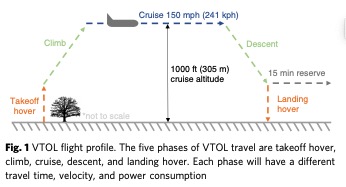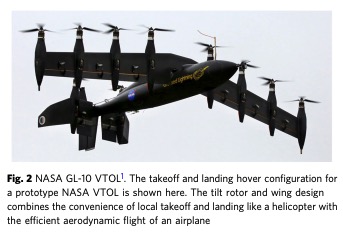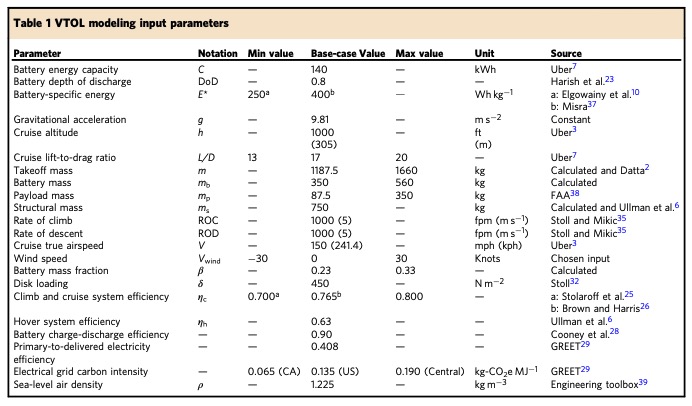NATURE COMMUNICATIONS
 Interest and investment in electric vertical takeoff and landing aircraft (VTOLs), commonly known as flying cars, have grown significantly. However, their sustainability implications are unclear. We report a physics-based analysis of primary energy and greenhouse gas (GHG) emissions of VTOLs vs. ground-based cars. Tilt-rotor/duct/wing VTOLs are efficient when cruising but consume substantial energy for takeoff and climb; hence, their burdens depend critically on trip distance. For our base case, traveling 100 km (point-to-point) with one pilot in a VTOL results in well-to-wing/wheel GHG emissions that are 35% lower but 28% higher than a one-occupant internal combustion engine vehicle (ICEV) and battery electric vehicle (BEV), respectively. Comparing fully loaded VTOLs (three passengers) with ground-based cars with an average occupancy of 1.54, VTOL GHG emissions per passenger-kilometer are 52% lower than ICEVs and 6% lower than BEVs. VTOLs offer fast, predictable transportation and could have a niche role in sustainable mobility.
Interest and investment in electric vertical takeoff and landing aircraft (VTOLs), commonly known as flying cars, have grown significantly. However, their sustainability implications are unclear. We report a physics-based analysis of primary energy and greenhouse gas (GHG) emissions of VTOLs vs. ground-based cars. Tilt-rotor/duct/wing VTOLs are efficient when cruising but consume substantial energy for takeoff and climb; hence, their burdens depend critically on trip distance. For our base case, traveling 100 km (point-to-point) with one pilot in a VTOL results in well-to-wing/wheel GHG emissions that are 35% lower but 28% higher than a one-occupant internal combustion engine vehicle (ICEV) and battery electric vehicle (BEV), respectively. Comparing fully loaded VTOLs (three passengers) with ground-based cars with an average occupancy of 1.54, VTOL GHG emissions per passenger-kilometer are 52% lower than ICEVs and 6% lower than BEVs. VTOLs offer fast, predictable transportation and could have a niche role in sustainable mobility.
The transportation sector faces the challenge of meeting growing demand for convenient passenger mobility while reducing congestion, improving safety, and mitigating emissions. Automated driving and electrification are disruptive technologies that may contribute to these goals, but they are limited by congestion on existing roadways and land-use constraints. Electric vertical takeoff and landing aircraft (VTOLs) could overcome these limitations by enabling urban and regional aerial travel services. VTOLs with tilt-rotor, duct, and wing designs, such as the GL-10 prototype designed by NASA, combine the convenience of local takeoff and landing like a helicopter with the efficient aerodynamic flight of an airplane. Although smaller and larger designs are possible, several companies are considering craft that can carry four to five occupants. Initially, these VTOLs would likely be piloted taxi services, but with advances in aviation regulation and sensor and processor technology, could transition toward future automated control.
Electrification is a propulsion strategy for improving the sustainability of both aerial and ground-based transportation modes, owing to the superior efficiency of electric powertrains compared with combustion engines. One critical efficiency enabler for VTOLs is distributed electric propulsion (DEP), which uses physically smaller, electrically-driven propulsors. These propulsors can be used with greater flexibility to leverage the benefits of aero-propulsive coupling and improve performance compared with more traditional designs. This enables aerodynamically optimized designs, such as articulating propellers and high aspect-ratio blown wings, which allow efficient VTOL energy performance and significant noise reduction. DEP could facilitate VTOL success in the urban aerial taxi space, where conventional helicopters or vertical-lift aircraft have struggled.
 In principle, VTOLs can travel the shortest distance between two points, and their relatively modest sizes would enable near point-to-point service. Conversely, road networks are much less direct and consequently have an associated circuity factor, defined as the ratio of the shortest network route to the Euclidian distance between two points. This benefit of VTOL aerial systems could favor energy and travel-time performance, particularly in locations with congested and circuitous routing. High VTOL cruise speeds could reduce travel time further. Significant time savings and associated productivity gains could be a key factor in consumer adoption of VTOL transportation.
In principle, VTOLs can travel the shortest distance between two points, and their relatively modest sizes would enable near point-to-point service. Conversely, road networks are much less direct and consequently have an associated circuity factor, defined as the ratio of the shortest network route to the Euclidian distance between two points. This benefit of VTOL aerial systems could favor energy and travel-time performance, particularly in locations with congested and circuitous routing. High VTOL cruise speeds could reduce travel time further. Significant time savings and associated productivity gains could be a key factor in consumer adoption of VTOL transportation.
There are many questions that need to be addressed to assess the viability of VTOLs including cost, noise, and societal and consumer acceptance. Our analysis assesses the environmental sustainability of VTOLs compared with ground-based passenger cars. There have been few studies of VTOLs’ potential climate change implications.
We report the first comprehensive assessment of the primary energy and GHG emissions impacts of using electric VTOLs vs. ground-based light-duty vehicles for passenger mobility. Our analysis first focuses on a vehicle-to-vehicle comparison with one occupant (i.e., the pilot or driver) traveling point-to-point distances ranging from 5 to 250 km. The base case is assessed for a 100 km distance. As part of a sensitivity analysis, we compare the results on a passenger-kilometer traveled (PKT) basis. The VTOL is assumed to have three passengers and one pilot (i.e., four occupants), as it will most likely be used in a transportation-as-a-service business model where service providers seek to maximize utilization rates. Ground-based cars are assumed to be personally owned with a typical loading of 1.54 passengers/ occupants. Modeling details are available in the Methods section, with uncertainties explored in the Sensitivity Analysis. We assess use-phase burdens associated with both aerial (well-to-wing) and ground-based (well-to-wheel) transport. Total fuel cycle impacts encompass both upstream (mining, refining, and transportation of the fuel source) and downstream (operational) activities. Burdens from other life cycle stages, such as vehicle production and end-of-life, are not considered owing to a lack of standardization in VTOL fabrication materials, manufacturing processes, and design specifications.
To quantify the use-phase sustainability of these mobility systems, two key metrics are chosen: primary energy use in units of megajoules [MJ] and GHG emissions in units of kilograms of carbon dioxide equivalents [kg-CO2e] on a 100-year global warming potential basis. Subsequently, differences in real-world occupancies are explored by normalizing those metrics on a PKT basis, which is useful when comparing different passenger transport modes. We also compare the travel time of VTOLs vs. cars. Piloted operation for both modes of mobility is the basis of our analysis. Connected and automated operation are beyond the existing scope and will be considered in future work.
We find that for our base case with 100 km point-to-point trips, VTOL GHG emissions are 35% lower than internal combustion engine vehicles (ICEVs), but 28% higher than battery electric vehicles (BEVs). Normalizing base-case emissions per PKT with expected loading gives VTOL burdens (with three passengers) that are 52% and 6% lower than for the ICEV and BEV (with 1.54 passengers), respectively. For short trips (up to 35 km), which dominate trip frequency for conventional cars, VTOLs have higher energy consumption and GHG emissions than ground-based vehicles. Time savings for VTOL rides compared with cars (83% for a 100 km trip) could act as a driver for consumer adoption. From the viewpoint of energy use and hence GHG emissions, it appears that VTOLs could have a niche role in sustainable mobility, particularly in regions with circuitous routes and/or high congestion.
…
Discussion
We present the first detailed sustainability assessment of VTOL flying cars. Although VTOLs are faced with economic, regulatory, and safety challenges, we determine that they may have a niche role in a sustainable mobility system. From the results of our assessment, four key insights for VTOL development can be drawn.
First, due to the significantly higher burdens associated with fewer passengers on-board, operators would have to ensure VTOLs fly at near-full capacities for them to outperform conventional ground-based vehicles. This might be a plausible scenario for two reasons. Current airline service providers already operate with similarly high utilization targets. Also, given the significant time savings of VTOLs over cars, passengers may be motivated to share rides with others to reduce higher costs expected of VTOL trips. While ridesharing in ground-based cars, passengers often have to tradeoff cost for travel time. This is not expected to be the case with VTOLs, with time-saving benefits being potentially important for their adoption. It should be noted here that single-occupant ground-based vehicles also have negative sustainability implications compared with fully loaded cars that combine passenger trips.
Second, VTOLs emit fewer GHGs on a VKT basis compared with ICEVs for trips beyond 35 km. However, the average ground-based vehicle commute is only about 17 km long, with trips exceeding 35 km accounting for under 15% of all vehicle trips. Hence, the trips where VTOLs are more sustainable than ICEVs only make up a small fraction of total annual vehicle-miles traveled on the ground. Subsequently, VTOLs will be limited in their contribution (and role) in a sustainable mobility system. For shorter distances, energy-intensive hover dominates the flight profile, thereby preventing the VTOL from leveraging efficient aerodynamic performance in cruise. VTOL sustainability performance is more advantageous when competing with groundbased vehicles traveling congested routes or indirect routes with higher circuity factors. The comparative energy, emissions, and time-saving benefits of VTOLs are maximized in areas with high congestion or with geographical barriers, which dictate indirect routing for ground-based transport. There could also be an opportunity to displace a portion of short-range regional jet travel with electric VTOLs to reduce GHG emissions. Small jets such as the Embraer 145 with a capacity of 49 passengers have a usephase well-to-wing GHG burden of 0.10 and 0.20 kg-CO2e PKT^-1 with load factors of 100% and 50%, respectively. This is comparable to VTOLs with one to three passengers emitting 0.15–0.06 kg-CO2e PKT^-1 for a 250 km trip.
Third, the GHG emissions of electric VTOLs scale with the carbon intensity of the electricity grid. The carbon intensity of most electric grids are expected to be substantially lower in the future, as more renewable generation is brought on-line. Hence, the benefits of electric VTOLs over conventional fossil-fuel-powered road transportation are expected to grow in the future
Fourth, lower VTOL emissions, enabled largely by DEP, are not strongly contingent on advances in energy storage. Although superior battery chemistries (and higher specific energies) favor VTOLs’ performance over BEVs (owing to greater weight dependencies for the former), they affect range more than they do sustainability impacts for either transport mode, as described in the Methods section.
Related work by Uber and Ullman et al. support the key takeaways from our study. Uber estimates a VTOL energy intensity of about 0.48 kWh km^−1 at 241 kph for an 80 km trip. No detailed breakdown of the VTOL energy modeling is provided. Under these conditions and assuming four occupants, the VTOL operational energy intensity yielded by our model is 0.43 kWh km^−1 (about 10% lower). Further, the Ullman et al. model of VTOL range and energy consumption was reproduced according to the physics-based relationships stated in the study. Using Ullman et al. model and input assumptions, the VTOL operational energy intensity is 0.57 kWh km^−1 for a 1360 kg VTOL at 241 kph for a 100 km trip. Using our baseline input assumptions instead, Ullman’s model produces an energy intensity of 0.37 kWh km^−1 (about 35% lower), which is the same as the output from our model for a fully loaded VTOL. Despite these studies reporting higher energy intensities, the comparison with ground-based vehicles still remains promising. Using the 2020 US average grid mix, Uber’s 0.48 kWh km^−1 and Ullman’s 0.57 kWh km^−1 translate to GHG emissions of 0.09 and 0.10 kg-CO2e PKT^−1, respectively (for three passengers on a 100 km trip). These compare favorably to the 0.07 and 0.13 kg-CO2e PKT^−1 results for the BEV and ICEV, respectively.
Our analysis provides an important first basis for assessing and guiding use-phase VTOL sustainability. Given the dynamic nature of rapid developments in the flying car space, VTOL deployment could emerge differently from our defined base case. This may alter our findings in unpredictable ways. Further, future work should consider the total vehicle cycle burdens for these aircraft, once there is more clarity on material selection, manufacturing processes, design, and disposal. Finally, despite certain sustainability benefits of VTOLs, their feasibility as a future transportation option depends on advances beyond those of a technical nature, including regulation, consumer, and societal acceptance of aerial transport in urban areas.
Download full version (PDF): Role of Flying Cars in Sustainable Mobility
About Nature Communications
www.nature.com/ncomms
Nature Communications is an open access journal that publishes high-quality research from all areas of the natural sciences. Papers published by the journal represent important advances of significance to specialists within each field.
Tags: Flying Cars, Nature Communications, University of Michigan, Vertical Takeoff, VTOL







 RSS Feed
RSS Feed